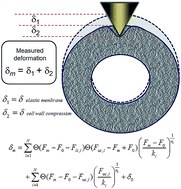Interpreting atomic force microscopy nanoindentation of hierarchical biological materials using multi-regime analysis†
Abstract
We present a novel Multi-Regime Analysis (MRA) routine for interpreting force indentation measurements of soft materials using atomic force microscopy. The MRA approach combines both well established and semi-empirical theories of contact mechanics within a single framework to deconvolute highly complex and non-linear force-indentation curves. The fundamental assumption in the present form of the model is that each structural contribution to the mechanical response acts in series with other ‘mechanical resistors’. This simplification enables interpretation of the micromechanical properties of materials with hierarchical structures and it allows automated processing of large data sets, which is particularly indispensable for biological systems. We validate the algorithm by demonstrating for the first time that the elastic modulus of polydimethylsiloxane (PDMS) films is accurately predicted from both approach and retraction branches of force-indentation curves. For biological systems with complex hierarchical structures, we show the unique capability of MRA to map the micromechanics of live plant cells, revealing an intricate sequence of mechanical deformations resolved with precision that is unattainable using conventional methods of analysis. We recommend the routine use of MRA to interpret AFM force-indentation measurements for other complex soft materials including mammalian cells, bacteria and nanomaterials.


 Please wait while we load your content...
Please wait while we load your content...